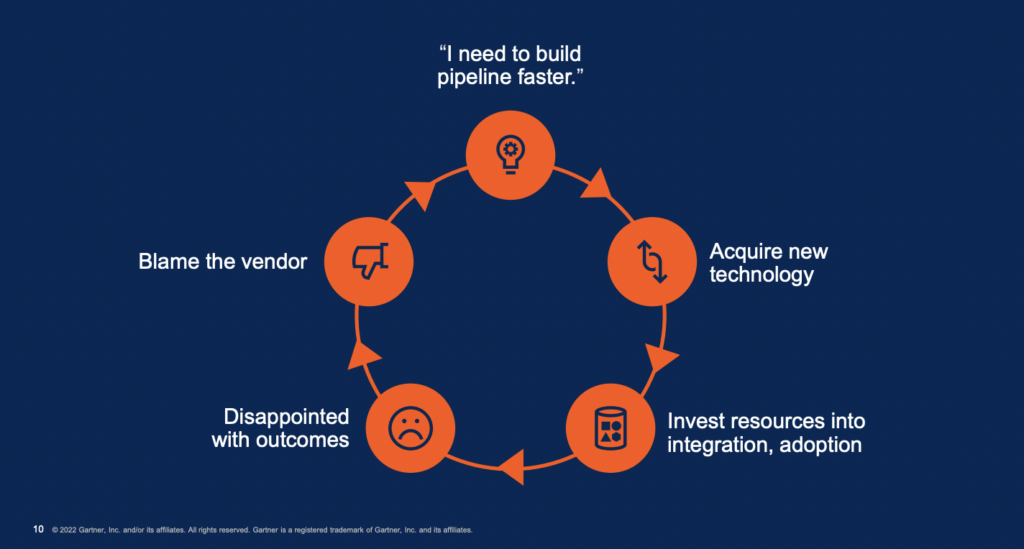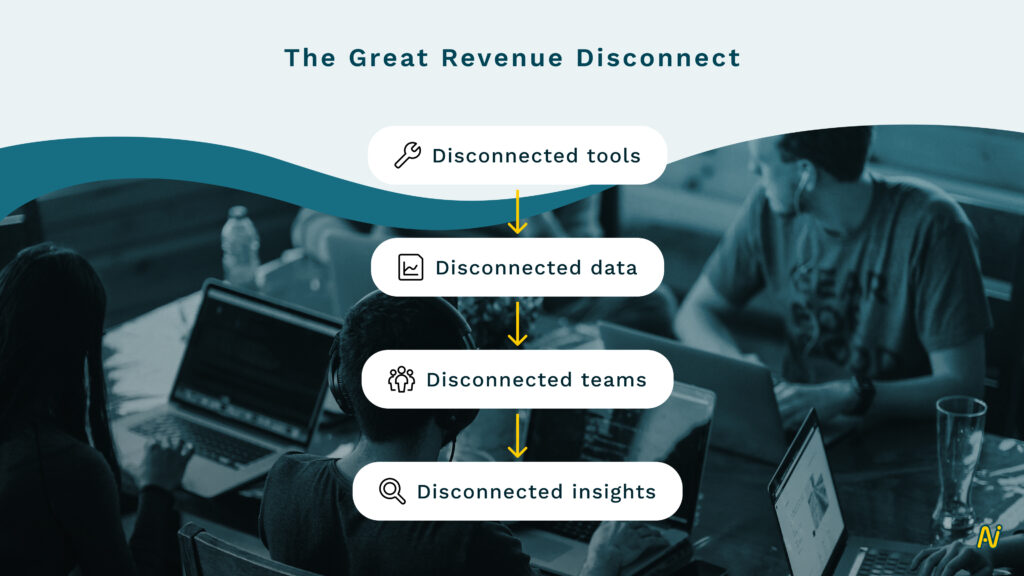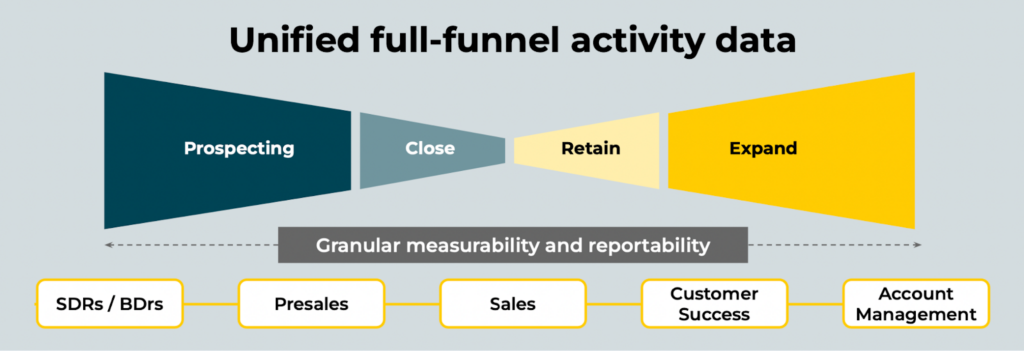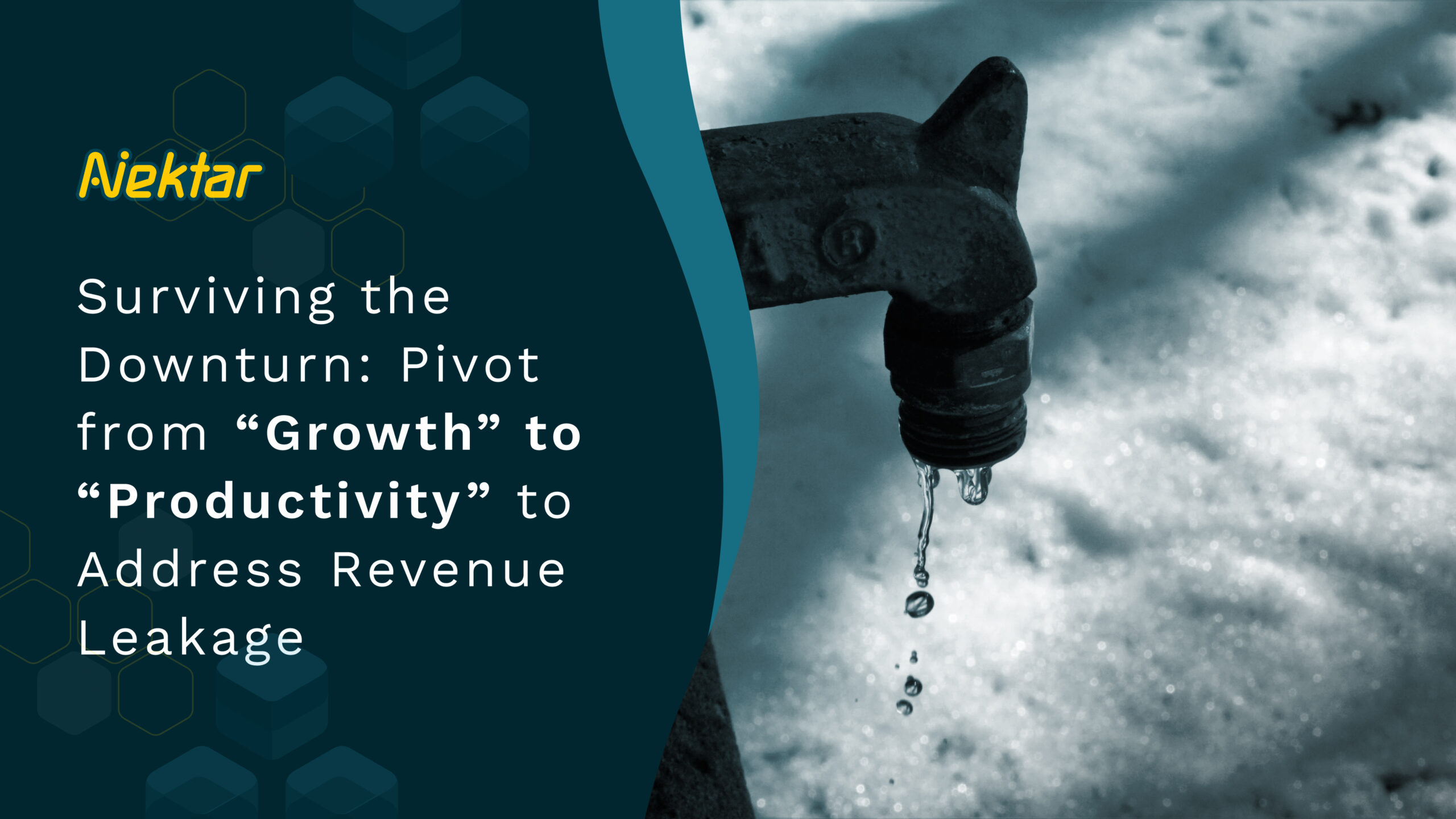The “growth at all costs” mantra of the last few years gave rise to the “shiny object syndrome” in tech investment. With cheap capital and easy funding, organizations kept adding tools to their tech stack to address a plethora of problems they faced.
This towering tech stack soon turned into a primary source of revenue leakage as it led to poor outcomes. If you’re wondering what that is, one of the definitions of revenue leakage is “the avoidable loss of revenue due to system failures in visibility, process, and execution.”
In short, the hype created around these tools failed to deliver on expectations. Adoption rates of tools like CRM continued to remain dismal. And teams utilized less than 50% of the potential of the sales tools that they bought.
Despite these poor results, companies kept throwing more money at the problems they faced. The tech stack continued to tower – forming a vicious cycle of tech investment.

As per Gartner, this vicious cycle constitutes 5 steps:
This continued investment in the revenue tech stack without really analyzing how the tech can help exacerbated the revenue leakage problem as a result of The Great Revenue Disconnect.

A growing stack of tools across customer-facing organizations has its own way of working. The tools that revenue teams do end up using don’t talk to each other. They operate within their own silos, have their own data, and create their own insights.
This keeps revenue teams like sales, marketing and customer success in the dark. Resulting in funnel-wide silos and data leaks. The result? Revenue leakage.
Not only is the ROI from these tech stacks poor, but this disconnect also leads to a significant loss of productivity across the go-to-market (GTM) funnel. Revenue operations teams fail to carry out a tight GTM alignment. They are constantly juggling between siloed tech stacks, disparate data sets scattered across the organization, and GTM teams that don’t collaborate.
However, organizations can no longer afford to ignore such operational inefficiencies and productivity leaks. Especially in the midst of one of the worst economic downturns currently looming over us.
The Downturn Has Squeezed All the Excess Cash
The vicious cycle of tech stack investment continued because there was no dearth of capital in the market. Every time a new shiny tool got introduced, businesses stood in line to invest in it.
But the downturn has made investors pull the plug on funds. Several businesses with double and even triple-digit growth during the pandemic are now facing a cash crunch. Businesses have to be mindful of their investments now.
What changed?
The definition of a ‘successful business’ did.
It’s no longer about growing with brute force with more processes, more technologies, or more people. The narrative of a successful business has shifted from growth to “productivity at all costs.”
Investors are asking deeper questions about business models. Are they profitable? Do they have good unit economics? What does the Lifetime Value of a Customer (LTV) look like?
This shift in perspective, along with advice from VC investment firms like Sequoia, Reach Capital, YCombinator and others – advising start-ups to create more runway for survival – is making founders cut deep on their costs.
The immediate impact is seen in a sweeping tide of layoffs in the tech sector. And the second immediate cost-cutting measure is to make revenue tech stacks leaner.
But here’s the thing. These immediate cost-cutting measures might serve as a quick-fix to the effects of the downturn. But it still does not address the much larger need to create sustainable business models.
Businesses need a model that not addresses the current downturn, but also looks at ways to survive the long game. Because uncertainties like the downturn or the pandemic are not going to magically disappear. And investors will become more cautious of this.
In the new world, investors are interested in businesses that have a clear path to profitability. And this is only possible if revenue leaders have crystal clear visibility into their day-to-day operations, are free from data silos, and have collaborative customer-facing teams.
Businesses are now forced to make that much-needed transformation by finally paying heed to the revenue leakage that has been staring at them for a while.
It’s Time to Address the Great Revenue Disconnect
The great revenue disconnect exists not because there is something wrong with the tools that organizations invest in. It’s the way processes are built around them, which in most cases is done in silos and not centrally by one function.
Take CRM for example. It’s one of the most significant investments that every organization makes. But 48% of sales leaders say their CRMs don’t meet their needs.
Does that mean businesses should stop using the CRM?
Absolutely not!
CRMs are, in fact, a great tool to help organizations develop better operational processes for their customer-facing teams. But only if it is managed the right way.
The secret to an efficiently run CRM system is high-quality data. The data that you feed into your CRM is what drives its efficiency. Otherwise, it’s a classic case of Garbage in, Garbage Out.
And that’s exactly what’s happening.
CRM data is not reliable. It fails to capture most of the data that comes in through various channels like emails, phone calls, meetings, demos and other sources.
This is because CRMs demand manual uploads from sellers when it comes to prospect information. 32% of salespeople are forced to spend an hour or more every day on manual data entry – losing productive work hours that could be spent selling.
And humans make mistakes. There is no way to validate if the entries made by sellers are correct or still valid. The result is your CRM getting piled on – day after day – with incomplete, missing, stale or incorrect data.
As high as 79% of opportunity-related data never makes it to the CRM. Imagine the loss.
Missing contact information that could have been used by sales teams for outreach, marketing teams for their personalized campaigns and customer success teams for retention. So many potential opportunities are lost.
And revenue leak also happens because of insights from bad data. For example, account-based marketing campaigns fail to deliver value. Or sales teams reach out to the wrong contacts. The collective revenue loss can be as high as $15m a year!
To survive this downturn in the wake of an unprecedented cash crunch, leaders must solve this problem and make tools work for their teams (not the other way around).
If revenue teams have visibility into every aspect of the business, and the data driving those insights are correct and up-to-date with no need for manual intervention, half the battle is already won.
But the real question is – How can they achieve this?
Enter unified full-funnel activity data.
Unified Full-Funnel Activity Data Champions the Sustainable Revenue Cause
The first step to building a sustainable business model in this downturn is to have access to clean and unified data.
Insights from clean and trustworthy data drive visibility across the customer lifecycle. It can help drive strategic business decisions and drive revenue across the go-to-market functions like sales, marketing and customer success.

Why is this necessary?
For subscription businesses, revenue generation does not just stop at closing a deal. It expands beyond selling products and services. Customers need to be continuously engaged and retained for more revenues.
Running a successful bow-tie model of SaaS businesses is possible with granular visibility into every part of the funnel (see image above). Revenue leaders need to be able to see what’s happening at each stage of the customer lifecycle. And know where the possible leaks exist.
With this unified view of clean data and insights, revenue leaders can run the right GTM ship. They know exactly what to do at any stage to keep the revenue engine running.
Let’s look at how unified full-funnel revenue data can help address various sources of revenue leaks:
1. Map Productivity to Performance
With unified activity data, you can map the productivity of your team members to their performance. By having granular visibility into activity data, revenue leaders can find answers to critical questions such as:
- How are my SDRs and CSMs spending their time?
- When did we last hold QBRs with our high-value customers?
- Are reps talking to the decision-makers in the current quarter forecasted deals?
- Are my reps following best practices from the company playbook?
- Which accounts did we touch last month?
- What is the speed to lead?
Complete and reliable activity data capture can help you identify winning behaviours or productivity patterns. Doubling down on what works can help drive revenue numbers.
What activities do high-performing reps engage in? How does it differ from average or low performers? A Head of RevOps can take those patterns and scale them up to the entire team – thus driving productivity.
For example, if there has been no activity happening in a high-priority account for a long time, a manager can find the reason. If a follow-up email is required, the manager can coach the rep immediately to do the same.
Clean and complete activity data surfaces the gaps and challenges in the sales process in real-time –so that revenue leaders can act on moments that matter. This improved productivity of your GTM teams, as they are able to use the insights from activity data to address issues that require immediate attention.
Most critical deals keep moving forward, and the whole team can see the direct impact of their actions on the pipeline.
2. Safeguard Transition Data
Many deals fall apart because key people in the B2B buying committee quit their jobs so often. The turnover among corporate director-level and above, which constitutes the majority of B2B buyers, increased by 31% in 2021.
When a key stakeholder leaves an organization, their contacts, buyer activity data and relationships leave with them. Reps start from scratch, causing 80% of them to lose deals.
This data leak prevents a lot of potential deals from closing as reps fail to form strong relationships with more than one person in the buying group. Without the right data, sellers scramble to identify who they should actually be pitching to in a buying group.
Unified activity capture helps capture contact information and buyer activity data for the entire buying committee and not just one key stakeholder. This keeps reps updated on the contact information of the entire buying committee. And on the occasion of a champion leaving, reps still know who to reach out to in order to continue the conversations.
This helps reps multithread and build relationships with the entire community, rather than a single person.
Multithreading increases the chances of closing a deal by 16%. With complete capture of contact data, reps can master multithreading by gathering champions, influencers and decision-makers, and engaging with them on a regular basis.
Nektar helps capture and match contact information to the corresponding opportunity automatically. This has a huge impact on who you target in the buying committee and how you engage with them. Sales teams can quickly and easily uncover answers to the questions they need to predict revenue and accelerate deals.
3. Proactively Manage Key Accounts
New-age investors are looking at metrics like Cost of Customer Acquisition (CAC) and Lifetime Value (LTC) of a customer in businesses. These metrics lay down a clear path to profitability. And customer retention plays a huge role in that.
With clear visibility into accounts, customer success teams can undertake effective account coverage. They can identify leading indicators that can help them engage with key accounts and help retain and expand them,
For example, the head of Customer Success will have visibility into how many of the customer success managers (CSM) are effectively engaging with the accounts.
- Are they able to build relationships beyond the original buying group?
- How can a CSM maintain relationships with the buying committee that go beyond the champion?
- Are CSMs identifying fresh relationships that can help expand the business?
Complete and fuller contacts help customer success teams identify whitespaces and de-risk renewals. They can identify churn early on with granular insight into account engagement. And work towards their expansion with minimal resources.
4. Make your Tech Stack Work Smarter
Tech stack continues to be a major source of investment for companies. An organization purchases 27 sales tools on an average. But 42% of sales teams fail to see a clear ROI on these tools.
Unifying hidden and scattered GTM data from all your existing tools like CRM helps mitigate this risk. With complete, accurate and superior quality data, you can improve the ROI of your existing GTM tools like CRM, business intelligence, ABM and conversation intelligence.
You can get more out of your existing tech stack with cleaner, fuller buying committee contacts and revenue activity data that enhances business insights.
Use these insights to drive strategic business decisions, reduce churn and drive end-to-end visibility for your revenue operations teams.
Address Revenue Leakage With Unified Data
With clean data presented in a unified view, revenue leaders have the visibility they need to drive necessary changes. And this visibility drives productivity across the organization. The GTM team of sales, marketing and customer success functions know exactly where to focus on to drive growth. This helps drive productivity.
And with visibility driving productivity, organizations can predict their forecasts better and more accurately. And build a scalable, repeatable and predictable revenue engine that can stand the test of time.

The downturn is the equalizer that has forced companies of all sizes to look deeper and address revenue leakage at its roots. Productivity at minimal cost is the differentiator that is a must-make pivot for organizations. And unified full-funnel activity data is the enabler that can help organizations make this much-needed transition to survive the downturn.
Plug revenue leakage with unified full-funnel data capture that unlocks productivity, visibility and predictability.
Take that first step towards building a sustainable business model today with Nektar. Speak to us to see how you can achieve sustained revenue growth by addressing the data leak issue.








